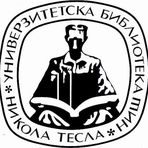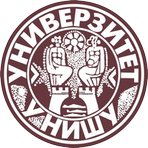Title
Oscilacije kompozitnih nanostruktura primenom teorija višeg reda
Creator
Despenić, Nikola, 1991-
CONOR:
60401673
Copyright date
2025
Object Links
Select license
Autorstvo-Nekomercijalno-Bez prerade 3.0 Srbija (CC BY-NC-ND 3.0)
License description
Dozvoljavate samo preuzimanje i distribuciju dela, ako/dok se pravilno naznačava ime autora, bez ikakvih promena dela i bez prava komercijalnog korišćenja dela. Ova licenca je najstroža CC licenca. Osnovni opis Licence: http://creativecommons.org/licenses/by-nc-nd/3.0/rs/deed.sr_LATN. Sadržaj ugovora u celini: http://creativecommons.org/licenses/by-nc-nd/3.0/rs/legalcode.sr-Latn
Language
Serbian
Cobiss-ID
Theses Type
Doktorska disertacija
description
Datum odbrane: 27.03.2025.
Other responsibilities
Academic Expertise
Tehničko-tehnološke nauke
University
Univerzitet u Nišu
Faculty
Mašinski fakultet
Group
Katedra za mehaniku
Alternative title
Vibration of composite nanostructures by using higher-order theory
Publisher
[N. Đ. Despenić]
Format
[14], 222 str.
description
Biografija autora: list. 218-219.
Bibliografija: list. 211-217.
description
Theoretical and applied mechanics
Abstract (en)
In this doctoral dissertation, the oscillatory characteristics of nanobeams and nanotubes were analyzed, considering the influence of various parameters on the change in the fundamental circular frequency, critical temperature, and critical fluid flow velocity. The dynamic equations were derived using Hamilton's principle, and analytical and numerical methods were applied to solve them. Special attention was given to structures made of functionally graded materials, which are significant due to their variable mechanical properties. Using Eringen's lower- and higher-order nonlocal theory, as well as strain gradient theory, mathematical models of the studied structures were presented. The change in the fundamental circular frequency with temperature variation was analyzed. Special emphasis was placed on the change in the fundamental circular frequency, critical temperature, and critical fluid flow velocity, with changes in the volume fraction exponent, lower- and higher-order nonlocal parameters, and the length scale parameter, allowing for a deeper understanding of nonlocal effects on the change in the fundamental circular frequency. It was demonstrated that the nonlocal parameter and length scale parameter affect material stiffness differently, and thus have different impacts on the change in the circular frequency of nanostructures. The influence of the geometric coefficient on the change in the circular frequency of a non-uniform nanotube was considered. In the case of the non-uniform nanotube, the fluid flow velocity is expressed as a function of the geometric coefficient, allowing for the analysis of the change in the critical fluid flow velocity through the non-uniform nanotube with the variation of the geometric coefficient.
Authors Key words
oscilacije, kružna frekvencija oscilovanja, nano-strukture, nelokalna teorija, nelokalna teorija gradijenta deformacije, nano-grede, nano-cevi, funkcionalno gradijentni materijali, kritična temperatura, kritična brzina strujanja fluida
Authors Key words
vibration, circular frequency, nanostructures, nonlocal theory, nonlocal strain gradient theory, nanobeams, nanotubes, functionally graded materials, critical temperature, critical fluid velocity
Classification
621.3.018:[539.32:539.216(043.3)
Subject
T 210
Type
Tekst
Abstract (en)
In this doctoral dissertation, the oscillatory characteristics of nanobeams and nanotubes were analyzed, considering the influence of various parameters on the change in the fundamental circular frequency, critical temperature, and critical fluid flow velocity. The dynamic equations were derived using Hamilton's principle, and analytical and numerical methods were applied to solve them. Special attention was given to structures made of functionally graded materials, which are significant due to their variable mechanical properties. Using Eringen's lower- and higher-order nonlocal theory, as well as strain gradient theory, mathematical models of the studied structures were presented. The change in the fundamental circular frequency with temperature variation was analyzed. Special emphasis was placed on the change in the fundamental circular frequency, critical temperature, and critical fluid flow velocity, with changes in the volume fraction exponent, lower- and higher-order nonlocal parameters, and the length scale parameter, allowing for a deeper understanding of nonlocal effects on the change in the fundamental circular frequency. It was demonstrated that the nonlocal parameter and length scale parameter affect material stiffness differently, and thus have different impacts on the change in the circular frequency of nanostructures. The influence of the geometric coefficient on the change in the circular frequency of a non-uniform nanotube was considered. In the case of the non-uniform nanotube, the fluid flow velocity is expressed as a function of the geometric coefficient, allowing for the analysis of the change in the critical fluid flow velocity through the non-uniform nanotube with the variation of the geometric coefficient.
“Data exchange” service offers individual users metadata transfer in several different formats. Citation formats are offered for transfers in texts as for the transfer into internet pages. Citation formats include permanent links that guarantee access to cited sources. For use are commonly structured metadata schemes : Dublin Core xml and ETUB-MS xml, local adaptation of international ETD-MS scheme intended for use in academic documents.


